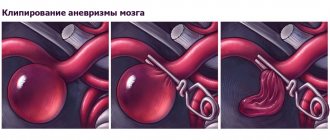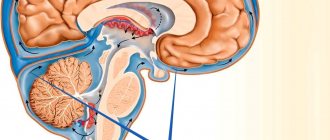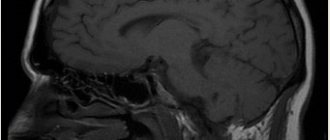Hydrocephalus in adults can be an independent disease or a manifestation of pathology of other organs and systems. In patients with hydrocephalus, the process of excessive accumulation of cerebrospinal fluid in the cerebrospinal fluid spaces, caused by disturbances in its production, circulation or absorption, is actively progressing. It is manifested by an enlargement of the ventricles of the brain, a decrease in the density of the brain matter due to its saturation with cerebrospinal fluid and a narrowing of the subarachnoid spaces. At the Yusupov Hospital, neurologists treat hydrocephalus with the most effective drugs that have a minimal range of side effects. Patients are examined using modern research methods performed by experienced specialists from the neurology clinic.
Symptoms
Mixed atrophic hydrocephalus of the brain is an acquired form of the disease. The pathology is characterized by enlargement of the cerebral ventricles and subarachnoid space in conditions of progressive brain atrophy.
Based on the rate of progression of the disease, the following are distinguished:
- acute hydrocephalus (no more than 3 days pass from the first symptoms of the disease to severe decompensation);
- subacute progressive hydrocephalus (develops within a month from the onset of the disease);
- chronic hydrocephalus (forms within 3 weeks to 6 months).
Based on the level of cerebrospinal fluid pressure, hypertensive, normotensive and hypotensive replacement hydrocephalus are distinguished. Mixed asymmetric hydrocephalus is characterized by an enlargement of one of the ventricles of the brain. Mixed hydrocephalus of a replacement nature occurs against the background of traumatic brain injury, arterial hypertension, cerebral atherosclerosis, instability of the cervical vertebrae, and alcoholism.
A distinctive feature of mixed hydrocephalus is the replacement of the vacated brain space with cerebrospinal fluid. Minor mixed hydrocephalus contributes to a decrease in cerebral blood flow. This leads to inhibition of neurological functions. If replacement hydrocephalus is accompanied by an increase in the volume of the cerebral ventricles, then a decrease in intracranial pressure is detected in patients, in other cases it will be increased.
Moderate mixed asymmetric hydrocephalus of the brain may be asymptomatic for a long period of time. Signs of ventricular asymmetry are determined during the examination of patients. Patients with replacement hydrocephalus complain of severe headache in the morning after waking up, caused by a long-lasting horizontal position of the body, nausea, and vomiting. They experience increased blood pressure, increased heart rate, and arrhythmia. The following signs of the disease are also determined:
- insomnia and sleep quality disturbances;
- drowsiness and lethargy;
- increased fatigue;
- irritability;
- decreased hearing and visual acuity;
- unsteadiness of gait, loss of coordination of movements.
In the later stages of the disease, symptoms of dementia appear: absent-mindedness, memory loss, impaired short-term memory, and inability to think logically. A severe complication of replacement hydrocephalus is epileptic syndrome. The patient develops dementia and may fall into a coma.
Features of mixed atrophic hydrocephalus
Doctors distinguish several forms of hydrocephalus:
- atrophic mixed hydrocephalus is a classic form of the disease, in which the volume of the brain decreases, and the vacated space is filled with cerebrospinal fluid;
- internal replacement hydrocephalus of the brain, in which the bulk of the fluid accumulates in the ventricles of the brain;
- mixed non-occlusive hydrocephalus, which is characterized by the accumulation of cerebrospinal fluid in the ventricles and in the space under the meninges.
With atrophic mixed hydrocephalus, intracranial pressure may increase, decrease, or remain unchanged. In case of increased intracranial pressure, hypertensive liquor syndrome develops. Moderate mixed non-occlusive hydrocephalus is asymptomatic for a long time and patients do not seek medical help. Despite the patient’s normal state of health, over time, signs of cerebral circulatory disorders appear. By contacting a neurologist in a timely manner, it is possible to avoid the unpleasant consequences of the disease.
Atrophic mixed hydrocephalus develops mainly in elderly people. In most patients, mixed replacement hydrocephalus occurs against the background of cerebral atherosclerosis, arterial hypertension, instability of the cervical vertebrae, traumatic brain injury, and alcohol abuse. When the volume of the brain matter decreases, the free space is occupied by cerebrospinal fluid.
Moderate mixed hydrocephalus of the brain leads to a decrease in the intensity of blood movement through the cerebral vessels. All brain functions are inhibited. If moderate mixed non-occlusive hydrocephalus is accompanied by enlarged cerebral ventricles, then patients experience decreased intracranial pressure, otherwise the cerebrospinal fluid pressure is increased.
With a moderate form of atrophic hydrocephalus, when the patient does not complain, treatment is not required. Patients are observed by neurologists at the Yusupov Hospital, they conduct a clinical examination, and monitor the condition of the ventricles and brain matter using magnetic resonance imaging. If signs of disease progression appear, conservative therapy is carried out.
As the cavity becomes larger and filled with an excess amount of cerebrospinal fluid, the process of death of brain cells occurs. The patient may require surgery. In this case, patients with hydrocephalus are consulted by a neurosurgeon. The doctor determines the presence of indications and contraindications for surgery. In the absence of adequate and timely treatment, hydrocephalus can lead to disability of the patient after several years.
Diagnostics
At the Yusupov Hospital, computer and magnetic resonance therapy are performed immediately after the patient’s admission to the neurology clinic. To assess the stage of hydrocephalus and determine indications for surgical intervention, doctors calculate ventriculo-cranial coefficients, which show the degree of expansion of the ventricular system. Computed tomography makes it possible to clarify the presence and extent of ischemic brain damage in patients with subarachnoid hemorrhage.
To predict the outcome of surgical treatment of replacement hydrocephalus, all patients undergo a tap-test. Its essence is that by removing at least 40 ml of cerebrospinal fluid during lumbar puncture in patients suffering from chronic hydrocephalus, their health status improves for a short time. If the test is positive, it is more likely that the patient will recover after surgery.
At the Yusupov Hospital, neurologists conduct a comprehensive examination of patients with replacement hydrocephalus. It includes ultrasound examination of the brain, craniography (x-ray of the skull), and fundus ophthalmoscopy. Patients are consulted by an ophthalmologist, cardiologist, and neurosurgeon.
If mixed replacement hydrocephalus occurs in a moderate form with minimal symptoms, patients are examined every 6 months for timely detection of negative dynamics of the disease. If there are pronounced signs of increased intracranial pressure, treatment is started immediately. In the case of severe replacement hydrocephalus, at a meeting of the expert council with the participation of professors and doctors of the highest category, tactics for managing the patient with hydrocephalus are developed.
What is mixed hydrocephalus
This term is used in medicine to define a human condition when fluid (CSF) accumulates in the brain. Its quantity may vary.
Hydrocephalus is a disease in which, for certain reasons, cerebrospinal fluid or cerebrospinal fluid, penetrating into the organ, does not exit and begins to accumulate.
There are many forms of the disease. But the most complex and difficult to treat is mixed. It is characterized by a violation of the outflow of cerebrospinal fluid both outside and inside the organ.
Mixed hydrocephalus is accompanied by pronounced symptoms, since the pathological process affects all parts of the brain, causing a disruption in their functioning.
The success of treatment depends on the timeliness of diagnosis, since in the early stages of the development of pathology there is a chance to completely cure it. Also, timely therapy can eliminate a number of dangerous diseases.
Classification
Hydrocephalus can be either acquired or congenital. The latter begins to manifest itself in infancy, while the acquired form is typical for adults and even elderly patients. Depending on the prerequisites for the appearance of hydrocephalus, the following types are distinguished:
- Closed, occlusive hydrocephalus occurs due to disruption of the flow of cerebrospinal fluid due to blockage of the fluid-conducting pathways. Most often, blockage occurs due to a tumor, the presence of a blood clot or adhesions.
- Open, or dysresorptive, hydrocephalus. It develops against the background of a violation of the structures that are involved in the process of absorption of cerebrospinal fluid into the system of cerebral veins (arachnoid villi, venous sinuses, cells and pachyonic granulations).
- Hypersecretory hydrocephalus. Production of large amounts of cerebrospinal fluid into the plexus of ventricular vessels.
- Replacement mixed hydrocephalus of the brain. It develops as a result of an increase in the amount of cerebrospinal fluid both in the subarachnoid space and in the cerebral ventricles. In this case, atrophy of brain tissue occurs.
The last option is considered the most dangerous to the life and health of the patient.
Causes
Mixed hydrocephalus of the brain develops for several reasons. Previously it was believed that the disease was specific to children. And today, pathology is most often diagnosed in newborns in the first six months of life or during intrauterine development.
Mixed hydrocephalus in children occurs as a result of birth trauma or infectious lesions during intrauterine development. Also among the reasons are:
- Violation of fetal development.
- Heredity.
- Poisoning of the fetus during gestation.
But mixed hydrocephalus is also diagnosed in adults. It has the following development factors:
- Alcohol poisoning.
- Overdose of drugs.
- Trauma to the skull and infectious lesions of the nervous system.
- Thinning of bone tissue as a result of calcium deficiency or various diseases.
- Atherosclerosis.
- Hypertension.
The disease in children causes not only mental, but also intellectual development. In adults, the pathology may not manifest itself for a long time, but over time it causes a deterioration in the quality of life.
Forms and types of hydrocephalus
Hydrocephalus of the brain, depending on the area of the organ in which the disorder occurs, is divided into the following types:
- Internal. Liquor accumulates in the ventricles of the brain, which is accompanied by a gradual increase in intracranial pressure. The fluid, as its quantity increases, begins to put pressure on different parts of the brain. As a result, there are not only disturbances in the functioning of the nervous system, but also in other processes. Patients also experience the appearance of various types of neoplasms.
- Outdoor. Several years ago it was classified as an independent pathology. Today it is classified as a type of hydrocephalus. But it differs in that it has other causes, and in the absence of therapy, other consequences arise. Along with an increase in fluid volume, a decrease in brain volume is observed. As a result of the changes occurring, the patient gradually loses some abilities and skills.
- Mixed. Not only the volume of cerebrospinal fluid increases, but also the brain itself. In addition, voids begin to form in the skull. It has been noted that elderly people are most susceptible to mixed hydrocephalus.
Depending on the nature of the course and intensity of symptoms, the disease is divided into two types: chronic and acute.
Treatment
When mixed hydrocephalus is established at an early stage of its development, drug treatment is used. Drugs are used to reduce intracranial pressure. Diuretics are also prescribed.
All medications should be prescribed only by the attending physician, who will determine the duration of use and dosage in accordance with the stage of development of the disease.
When mixed hydrocephalus is diagnosed, other treatment methods are also used. The course of therapy may include special therapeutic massage, physiotherapeutic treatment methods, such as UHF or electrophoresis.
Surgical intervention
Depending on the severity of the pathology, surgical intervention may be prescribed. Today, bypass surgery, drainage installation and endoscopy are used. Bypass surgery involves the installation of special shunts that will facilitate the outflow of cerebrospinal fluid. But the procedure is traumatic and can cause infection of the membranes of the brain. It is used in rare cases when other methods cannot be used.
Drainage is used for high intracranial pressure. Endoscopic surgery is aimed at creating holes in the ventricles of the brain. It is considered the most gentle way to eliminate large amounts of fluid in the skull. The method of performing the operation is selected by the attending physician.
Manifestation of neurological disorders
Neurological disorders with mixed replacement hydrocephalus of the brain in adults will manifest themselves as follows:
- Decreased quality of vision – bifurcation and difficulty focusing the gaze on one object.
- Loss of visual fields.
- Against the background of constant compression, atrophy of the optic nerve occurs, which in the future can cause complete loss of vision.
- Strabismus.
- Lack of pupillary response to bright light.
- Dysfunction of the vestibular system. Dizziness, unsteadiness in gait, tinnitus, and involuntary vibrations of the eyeballs appear.
- Paralysis of limbs.
- Increased reflexes and muscle tone.
- Decreased or complete loss of sensitivity.
- Involuntary fixation of the arms and legs, when due to increased tone it is impossible to straighten the limbs.
- Symptoms of cerebellar ataxia, accompanied by impaired motor function and splayed handwriting.
- Unstable emotional state, sudden mood swings.
- With a sharp increase in cerebrospinal fluid pressure, aggression occurs.
The combination of symptoms and diagnostic measures taken indicate mixed hydrocephalus.









